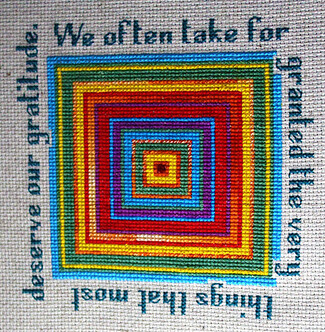Off the Mat: The Gratitude Muscle
The Gratitude Muscle
 Gratitude is one of the decade’s buzzwords, printed in cheerful fonts on memes and magazine covers. And for a good reason: research shows that gratitude positively impacts cardiovascular health, immunity, and even our neurological wiring. Dr. Robert Emmons at UC Davis studies how gratitude changes the social-emotional area of our brains. He says that practicing gratitude is essential for our mental health.
Gratitude is one of the decade’s buzzwords, printed in cheerful fonts on memes and magazine covers. And for a good reason: research shows that gratitude positively impacts cardiovascular health, immunity, and even our neurological wiring. Dr. Robert Emmons at UC Davis studies how gratitude changes the social-emotional area of our brains. He says that practicing gratitude is essential for our mental health.
I joined the public gratitude parade when my son was a baby. Following the example of a high school friend, I set the intention to post three things each day for which I was grateful. I didn’t think much, just put down memories of the day: a cute kid anecdote or serendipitously timed train or exquisite snowfall. My posts gave friends a glimpse into my day and – or at least I hoped – something cheerful on their homepages amidst the complaints and clickbait.
Gratitude – Saturday, March 13, 2010: Being fed cheerios from applesauce covered hands.
When a friend commented, should-ing on herself with deprecating comparisons to my positive attitude, I replied with my truth; writing these notes is a discipline to compel me to pause and notice the here and now humanity of my life.
Interestingly, admitting my tool broke its spell. It felt forced, fake. Apparently, I’m not alone. To-Do List gratitude can have the opposite effect from what’s intended. In one study Dr. Emmons sites, researchers found folks who wrote five details about one thing they are grateful for were less tired and more positive than people who one detail about five things.
I have no desire to play into the isn’t-my-life-perfectly-worthy-of-being-pinned conceit any more than I exercise for a tight butt or flat belly. I want gratitude – like physical exercise – that grows health from the inside.
Gratitude – Monday, October 12, 2009: Sore muscles from a good workout Saturday morning. This may have been the first class I’ve felt up to doing 100% since getting pregnant, so I’ve got the good body aches to show for it!
How we look at our daily circumstances helps train our brains to take things in stride when times get tough. Our nervous systems are wired to look for the negative. This alert response has helped ensure our survival as a species. And yet, I want to do more than survive. I want to thrive, change, enjoy. Acknowledging how good I have it in this life, it’s ok to also recognize that being human – raising humans – loving humans – is still hard. I want to live in the both/and space. I can acknowledge my struggles, feel despair, challenge injustices AND delight in hearing my child’s laughter. Recognize how we are all in this together. Even appreciate the life lesson before me.
Gratitude – Thursday, April 8, 2010: One of us has 2 ear infections, another a root canal and abscess cleaned, the third intensive training week at work. But ya know? I was able to take it all in stride – ice pack on my jaw and lethargic baby on my chest, snoozing in the chair together. Life could be a LOT worse!
So this month, I’m going back to the gym. And I’ve reinstated my gratitude practice. Only this time – so I don’t break the spell – I will refrain from putting my gratitude on public display. This time, it’s personal.
photo credit: cauchy09
ABOUT THE AUTHOR
Ginny Hamilton
Pain specialist, yoga instructor, and Reiki practitioner Ginny Hamilton teaches simple & proven techniques to release pain & restore energy in the workplace, group classes & private sessions. She has put down roots in South Amherst with her spouse and young son. Daily she’s amazed by the beauty the Pioneer Valley offers, though her allergies beg to differ. In Off the Mat, Ginny explores how yoga’s physical and mindfulness exercises help her parent and how parenting shapes her yoga practice. http://www.ginnyhamilton.com
 Hilltown Families
Hilltown Families 





























